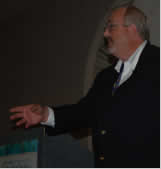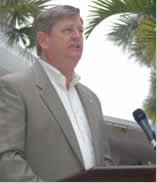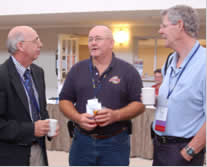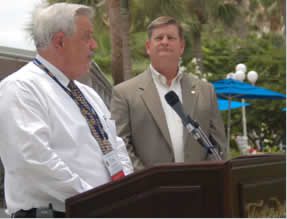
Vol. 3, No. 6, June 2007 |
 Printer-Friendly PDF Version Printer-Friendly PDF Version |
Contents |
SART Conference Is A Hit With Attendees
|
| ||||||||||
[top]
Awards Presented At Conference
Several individuals were recognized for leadership and exceptional service during the 2007 Florida SART Conference at the TradeWinds Resort in St. Petersburg May 30-June 1. “These individuals typically seek no recognition or reward, other than the personal satisfaction they receive from their efforts,?said Joe Kight, Florida ESF 17 Coordinator. On behalf of the SART program, Joe recognized “one individual from each of the four distinct partnership groups that form the SART family: federal, state, local/county and volunteer partners.?Florida Commissioner of Agriculture & Consumer Services Charles Bronson spoke during the luncheon and assisted in the brief awards ceremony. Florida State Veterinarian and Chief of the Division of Animal Industry Tom Holt read the awards as follows:
| ||||||||||||||||||||||||||||||
|
Straight from the conference podium ? "As a responder in an emergency situation, remember that you must take care of yourself first. Unless you do that, there's a good chance that you won't be in a position to help anyone else."Of course, you'll need to watch out for downed power lines, precarious tree limbs, flooding, sinkholes, dangerous animals, and other natural hazards. However, also be aware that the people you come in contact with could be dangerous or have anti-government feelings, including criminals, members of organized hate groups, animal rights extremists, environmental activists, and the mentally ill. "Unfortunately, you won't have the luxury of running background checks, and you could come face-to-face with dangerous people you know little or nothing about. Just keep in mind that not everyone will think you're wonderful, even though you're there to help. Even the victims can hurt you. In emergency situations, when people have suffered loss and are under great stress, many of them do things they wouldn't normally do. Sometimes good people do bad things. "The bottom line is that violence often is predictable, so to have the best chance of protecting yourself be continually aware of your surroundings and watch for signs of pending aggression." Tom Ackerman, Assistant Special Agent-in-Charge |
Seen, but not heard: editor and mediator needed ?fast!


That sneaky SART Advisory Board is
at it again, “Meering?together in the
Blue Heron room.
(Photo by the Editor)This is surely one tough
neighborhood in rural Volusia
County. (Photo by the Editor)
Exotic Update: The Nile Monitor
 Todd Campbell of the University of Tampa with a captured Nile monitor. “Eradication is the only viable answer,?Campbell says, “and there is no time like the present.
Todd Campbell of the University of Tampa with a captured Nile monitor. “Eradication is the only viable answer,?Campbell says, “and there is no time like the present.
Reports are in and they are not good.
According to Melissa Kaplan’s Herp Care Collection web site (quoting a report for the San Diego Herpetological Society by Mark Baumann) at http://www.anapsid.org/nile.html, “With a lot of patience, frequent handling, and a well stocked first aid kit, Nile monitors can be tamed.?And this from a site that loves (not loathes) reptiles! Straight from the conference podium ?
Craig Fugate, Director
According to www.MyFWC.com, the Nile monitor was first discovered wild in Florida in 1990. A self-sustaining, breeding lizard population has apparently been established in Lee County ?the Ft. Myers-Cape Coral area ?for more than 10 years; individual sightings (without self-sustaining populations at this time) have been verified in Alachua, Broward, Collier, Dade, DeSoto and Orange.
The Nile monitor is a fresh water species, but it tolerates brackish and fouled or contaminated water. A native of Africa, males may grow to 7 feet in length and can run up to 18 mph! It is described as hardy with an aggressive temperament, a powerful bite, sharp claws and lashing tail. Not your back yard bug-eater, this is a lizard with an attitude and researchers describe it as "very smart".
MyFWC.com even notes that the monitor “… is the second most commonly sold African monitor species in the United States (Faust 2001), despite the fact that its large adult size and nervous disposition make it a difficult pet to keep.?This presumably accounts for their established presence in Florida. People enjoy them as small pets (in the same manner as kittens and puppies), but once they become large, and of breeding size and age, their naturally aggressive nature becomes a problem and owners, because they are gentle at heart and cannot locate a herp lover who will take the adult, turns the animal loose in a nearby canal or stream. The other possibility for the established population ?assuming the lizard did not swim across the Atlantic Ocean ?is intentional release, which would truly be a crime.
Consider that this new resident of the Sunshine State eats almost anything that does not eat it first: fish and tortoises, pelicans and sea turtles, cats, dogs and perhaps ?this has Not been documented ?small children.
"They're not limited by anything and they're definitely breeding," says Todd Campbell, an assistant professor and ecologist at the University of Tampa, who was quoted in 2004 for http://nationalzoo.si.edu/Publications/ZooGoer/2005/3/reptilefeature.cfm. "We've caught only 80. There are probably in the high hundreds or thousands out there. They are currently highly localized in the Cape Coral area, but we've also had sightings in some troublesome places, such as nearby Pine Island. If they breed there, they would be very difficult to eradicate."
With the possibility that the Nile monitor lizard can spread throughout the U.S. southeast, surviving frost and cold weather in underground burrows, the National Zoo site suggests that located lizards must be “immediately eliminated.?[For additional information read http://static.ut.edu/public_info/Lizard-Tales.cfm.]
Florida Division of Emergency Management
About the SART Sentinel
Editor: Rick Sapp, PhD, Technical Writer, Florida Department of Agriculture & Consumer Services, Division of Animal Industry [rsa5@cox.net]
Associate Editor: Joe Kight, State ESF-17 Coordinator, Florida Department of Agriculture & Consumer Services, Division of Animal Industry [kightj@doacs.state.fl.us]
The SART SENTINEL is an E-mail newsletter prepared monthly by Rick Sapp and the members of the Florida State Agricultural Response Team. Past issues of the Sentinel are archived on the Florida SART Web Site, www.flsart.org.
If you have a story or photo that you would like to have considered for publication in The SART SENTINEL, please contact the Editors.














